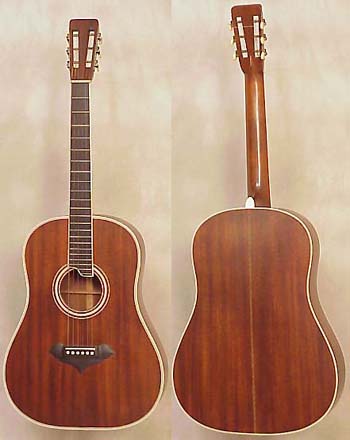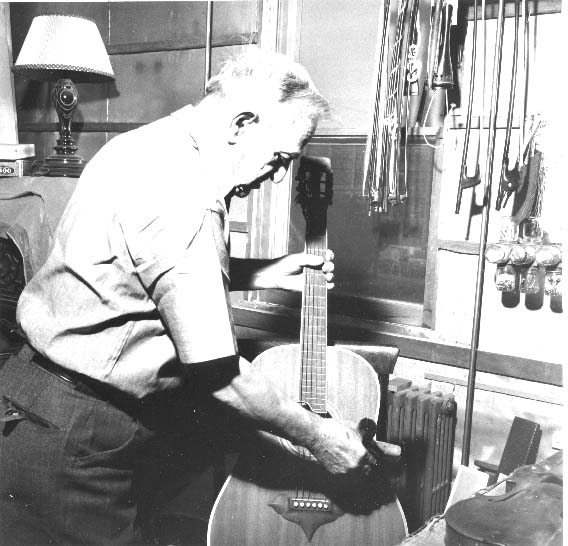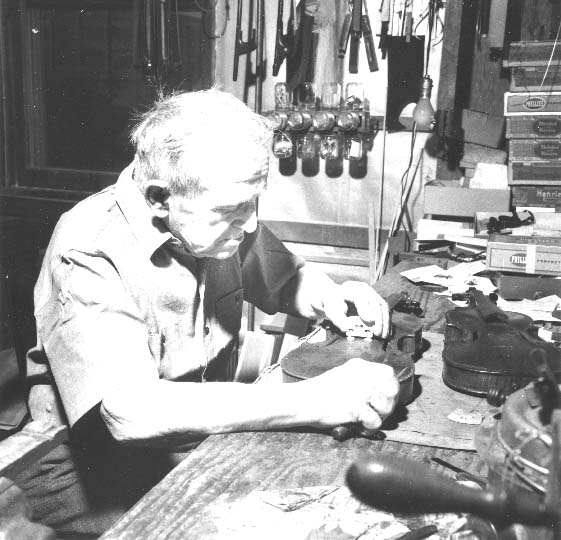Deichman/Martin prototype dreadnought
 Martin factory foreman John Deichman has stated that this all-mahogany guitar (inv. #AA5532) was his prototype for the Martin-made Ditson dreadnoughts of 1916, which were the forerunners of the Martin-brand dreadnoughts the company introduced in 1931. This extremely important historic instrument has been professionally restored and is priced with hard case at $50,000. (Click on framed images for larger view.)
Martin factory foreman John Deichman has stated that this all-mahogany guitar (inv. #AA5532) was his prototype for the Martin-made Ditson dreadnoughts of 1916, which were the forerunners of the Martin-brand dreadnoughts the company introduced in 1931. This extremely important historic instrument has been professionally restored and is priced with hard case at $50,000. (Click on framed images for larger view.)Deichman came to work for Martin in the early 1900s. After making some violins and failing to the company to add violins to the Martin line, he built a ukulele and suggested Martin sell ukes. By the time Martin put ukes into production (1918), Deichman had already turned his attention to Hawaiian guitars. According to a 1988 article in Frets magazine, Deichman made a Hawaiian guitar with an extra-wide mahogany body, a less-pronounced waist than the 000-size (Martin's largest body at the time), and a mahogany top.
That guitar was hanging on the wall at Deichman's workbench when Harry L. Hunt of the Ditson company noticed it and asked for more of the same, but in Spanish style rather than Hawaiian. Hunt agreed to Deichman's suggestion of a spruce top for better sound, but Hunt liked the look of the mahogany top, so the Ditsons were stained to a dark color. These were the first Martin dreadnoughts.
Deichman, who died in 1981, always said he made the all-mahogany prototype in 1916, but his claim is clouded by the date "2 28 17" stamped on the neckblock and by Martin's shipping records, which show six Ditson dreadnoughts leaving the factory three months earlier, in December 1916. On the other hand, factory records are not at all clear regarding specs on the original Ditsons six Ditsons (none of which has ever shown up). Other early Ditson dreadnoughts have fan-pattern top bracing rather than Martin's famous X-pattern. At the time, Martin did use the fan pattern on Hawaiian guitars made for the Southern California Music Company. It seems odd for the Spanish-style Ditson dreadnoughts to have Hawaiian-style bracing unless, of course, the prototype was a Hawaiian model.
Although the truth may never be resolved, the consensus among longtime Martin factory workers has always been that Deichman did indeed make the prototype for the dreadnought. And this guitar remains historically important as an instrument handmade by John Deichman as well as the probable prototype.
This instrument is SOLD
For further enjoyment...
|
Close shot of body Close of bridge Soundhole Date stamp on inside back Peghead Back of peghead Close shot of back Neck heel Side shot of body |
 |
 |
